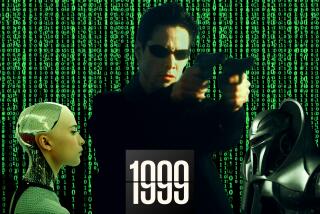In the Future, Every Molecule Will Have 15 Minutes of Fame
Just because a discipline still exists largely in science fiction is no reason it can’t have its own university department. The California NanoSystems Institute at UCLA and UC Santa Barbara means to take us beyond the computer chip to a world where molecules themselves can be controlled, with revolutionary implications for medicine, engineering and, well, fashion. If all of this is tough to envision, look no farther than UCLA, where professor Victoria Vesna, media arts department chairwoman, is mounting a series of ambitious nano-themed art installations in collaboration with nano- scientist James Gimzewski and others. The Zero@ wavefunction art show is online at www.notime.arts.ucla.edu/zerowave; the next project debuts at LACMALab in December. We asked Vesna to go molecular on us.
Leonardo da Vinci was a scientist as well as an artist, but these days you can dump the contents of your closet on the floor and have an award-winning art installation. What do nanoscience and art have to do with each other?
Nanoscientists more than other scientists need to talk to creative people because they cannot use the same paradigm that has been used in scientific research. Imagine it’s 1903. You and I are sitting in front of a gas lamp and you tell me you heard about something called electricity. You and I can’t imagine what that’s going to mean in 100 years. The genome was just decoded. There are satellites orbiting our planet. We’re sitting here talking on our cell phones and we think we’re so cool, but we have no idea where we’re going to be in another 100 years.
The “Matrix” films paint a disastrous picture of humanity’s interface with technology. In the future, will our bodies be covered in data ports?
We are the ultimate nanomachines. Nature doesn’t build with machines. It builds with molecules.
What are “nanobots”--and will they pay our bills and take out the trash?
The classic example is an imaginary being on a molecular scale that repairs cells. You would have your body repaired with this nanobot.
Your art project attempts to give visitors a feel for nanotechnology. How does it work?
The idea is to take the Buckminster Fullerene molecule, blow it up on large buildings and allow people to manipulate it with their shadows. They are enacting what happens on a molecular scale. There’s a playful and beautiful movement. If you don’t know anything about nanotech, you still have a great experience. We also started Windows to Nanotech [a Web-cam tour], where we have cameras scanning microscopes and you can look through and walk through the lab.
Is this art imitating life, life imitating art, or . . . ?
A nanoscientist has to work with biologists, chemists, engineers, you name it. They cannot be a separate discipline. Scientists who are trying to address molecular scale creatively gravitate toward artists and writers who are visionary. The same is true for the art that I’m pursuing. It cannot exist in a cultural realm like art did up to this point where it’s confined to the museum.
Are drawing and sculpture headed the way of the cave painting?
It already has in my mind. Though when you think of virtual reality, you’re really talking about a cave painting. You’re enacting a scene and you’re in it and you believe it’s real.
Will nanotechnology bring “The Jetsons” to life?
It will be more about how we perceive the world. The approach to medicine and healing will shift radically. The way we build things will shift radically, but most of the way we experience our material world will shift.
How far out could it get?
I really believe we’re going to have smart materials and smart clothes. You’ll be able to move through different parts of the planet without feeling that you have to own property. We’ll communicate without technology as we know it now. The world now is full of technological crutches that help us communicate. In the future, we won’t need any of that.
Dr. Evil better not get his hands on this stuff. Is nanoscience on Big Brother’s radar screen?
Fear is about change. Things like Michael Crichton’s book “Prey” continue this image of these swarms attacking people. I’m not sure this is a positive way to create dialogue. Basically it’s creating paranoia in the general public around science. The images projected out there are far from what’s possible. Nanotech at this point is very much in the imagination.
Do androids dream of electric sheep?
Absolutely. Why not? They can dream anything they want.
More to Read
The biggest entertainment stories
Get our big stories about Hollywood, film, television, music, arts, culture and more right in your inbox as soon as they publish.
You may occasionally receive promotional content from the Los Angeles Times.










